| Revision as of 07:34, 30 May 2020 edit2409:4042:2e24:a173:edf1:e55d:e289:5232 (talk) 1.5% are Christians, 6.9% are other religious and remaining 91.6% are both Buddhists and Shintoists, as per the sourceTags: Mobile edit Mobile web edit← Previous edit | Revision as of 07:35, 30 May 2020 edit undo2409:4042:2e24:a173:edf1:e55d:e289:5232 (talk) MovingTags: references removed Mobile edit Mobile web editNext edit → | ||
| Line 12: | Line 12: | ||
| | color3 = DarkRed | | color3 = DarkRed | ||
| }} | }} | ||
| {{bar box | |||
| |title=Religion in Japan (2015)<ref>https://www.pewresearch.org/wp-content/uploads/sites/7/2017/11/Religion20171117.pdf</ref><ref>https://www.indexmundi.com/japan/religions.html</ref><ref>https://www.learnreligions.com/religion-in-japan-4782051</ref><ref>https://www.cia.gov/library/publications/the-world-factbook/fields/401.html</ref><ref>https://www.cia.gov/library/publications/the-world-factbook/geos/ja.html</ref> | |||
| |titlebar=#ddd | |||
| |float=right | |||
| |width=420px | |||
| |bars= | |||
| {{bar percent|]|purple|70.4}} | |||
| {{bar percent|]|brown|69.8}} | |||
| {{bar percent|]|red|1.5}} | |||
| {{bar percent|others|green|6.9}} | |||
| |caption=Total adherents exceeds 100% because many ] practice both Shintoism and Buddhism. | |||
| }} | |||
| ] (] ]) statue at ], ] in ]. It is the fourth tallest statue in the world.]] | ] (] ]) statue at ], ] in ]. It is the fourth tallest statue in the world.]] | ||
| ] is an ancient site of ''kami'' worship.]] | ] is an ancient site of ''kami'' worship.]] | ||
| Line 29: | Line 18: | ||
| ] on ] for the worship of the mountain's god.]] | ] on ] for the worship of the mountain's god.]] | ||
| ] and ] are the two major '''religions in Japan'''. According to the annual statistical research on religion in 2015 by the Agency for Culture Affairs, ], 70.4 percent of the population practices ], 69.8 percent ], 1.5 percent ], and 6.9 percent others. Total adherents exceeds 100% because many ] practice both ] and ].<ref>https://www.pewresearch.org/wp-content/uploads/sites/7/2017/11/Religion20171117.pdf</ref><ref>https://www.indexmundi.com/japan/religions.html</ref><ref>https://www.learnreligions.com/religion-in-japan-4782051</ref><ref>https://www.cia.gov/library/publications/the-world-factbook/fields/401.html</ref><ref>https://www.cia.gov/library/publications/the-world-factbook/geos/ja.html</ref> Most of the Japanese (50% to 80% considering degrees of syncretism with Buddhism, '']''<ref name=ReischauerJansen215>{{cite book|publisher= Belknap Press of Harvard University Press|isbn= 978-0-674-47184-9|first1= Edwin O.|last1= Reischauer|author1-link= Edwin O. Reischauer|first2= Marius B.|last2= Jansen|author2-link= Marius Jansen|title= The Japanese today: change and continuity|url= https://archive.org/details/japanesetodaycha00reis|url-access= registration|year= 1988|edition= 2nd|page= }}</ref>) pray and worship ancestors and gods (神, '']'', ''shin'' or, archaically, ''jin'') at ]s or at private altars, while not identifying as "Shinto" or "Shintoist" in surveys.<ref name="Breen, Teeuwen. 2000. p. 3">Breen, Teeuwen. 2000. p. 3</ref> This is because these terms have little meaning for the majority of the Japanese,<ref name="Breen, Teeuwen. 2000. p. 3"/> or because they define membership in Shinto organizations or sects.<ref name="Engler, Price. 2005. p. 95">Engler, Price. 2005. p. 95</ref><ref name="Williams, 2004. pp. 4-5">Williams, 2004. pp. 4-5</ref> The term "religion" (宗教, ''shūkyō'') itself in Japanese culture defines only ]s (that is, religions with specific doctrines and required membership).<ref name="Bestor, Yamagata. 2011. pp. 66-67">Bestor, Yamagata. 2011. pp. 66-67</ref> People who identify as "non-religious" (無宗教, ''mushūkyō'') in surveys actually mean that they do not belong to any religious organization, even though they may take part in Shinto rituals and worship.<ref name="Bestor, Yamagata. 2011. pp. 66-67"/> Jesse LeFebvre has explored the manner in which "non-religiousness" is deployed as an identity by Japanese in articulating their religious outlook.<ref>LeFebvre, J. (2015). Christian wedding ceremonies: “Nonreligiousness” in contemporary Japan. Japanese Journal of Religious Studies, 42(2), 185-203. http://nirc.nanzan-u.ac.jp/nfile/4454</ref> | ] and ] are the two major '''religions in Japan'''. According to the annual statistical research on religion in 2015 by the Agency for Culture Affairs, ], 70.4 percent of the population practices ], 69.8 percent ], 1.5 percent ], and 6.9 percent others. Total adherents exceeds 100% because many (91.6%) ] practice both ] and ].<ref>https://www.pewresearch.org/wp-content/uploads/sites/7/2017/11/Religion20171117.pdf</ref><ref>https://www.indexmundi.com/japan/religions.html</ref><ref>https://www.learnreligions.com/religion-in-japan-4782051</ref><ref>https://www.cia.gov/library/publications/the-world-factbook/fields/401.html</ref><ref>https://www.cia.gov/library/publications/the-world-factbook/geos/ja.html</ref> Most of the Japanese (50% to 80% considering degrees of syncretism with Buddhism, '']''<ref name=ReischauerJansen215>{{cite book|publisher= Belknap Press of Harvard University Press|isbn= 978-0-674-47184-9|first1= Edwin O.|last1= Reischauer|author1-link= Edwin O. Reischauer|first2= Marius B.|last2= Jansen|author2-link= Marius Jansen|title= The Japanese today: change and continuity|url= https://archive.org/details/japanesetodaycha00reis|url-access= registration|year= 1988|edition= 2nd|page= }}</ref>) pray and worship ancestors and gods (神, '']'', ''shin'' or, archaically, ''jin'') at ]s or at private altars, while not identifying as "Shinto" or "Shintoist" in surveys.<ref name="Breen, Teeuwen. 2000. p. 3">Breen, Teeuwen. 2000. p. 3</ref> This is because these terms have little meaning for the majority of the Japanese,<ref name="Breen, Teeuwen. 2000. p. 3"/> or because they define membership in Shinto organizations or sects.<ref name="Engler, Price. 2005. p. 95">Engler, Price. 2005. p. 95</ref><ref name="Williams, 2004. pp. 4-5">Williams, 2004. pp. 4-5</ref> The term "religion" (宗教, ''shūkyō'') itself in Japanese culture defines only ]s (that is, religions with specific doctrines and required membership).<ref name="Bestor, Yamagata. 2011. pp. 66-67">Bestor, Yamagata. 2011. pp. 66-67</ref> People who identify as "non-religious" (無宗教, ''mushūkyō'') in surveys actually mean that they do not belong to any religious organization, even though they may take part in Shinto rituals and worship.<ref name="Bestor, Yamagata. 2011. pp. 66-67"/> Jesse LeFebvre has explored the manner in which "non-religiousness" is deployed as an identity by Japanese in articulating their religious outlook.<ref>LeFebvre, J. (2015). Christian wedding ceremonies: “Nonreligiousness” in contemporary Japan. Japanese Journal of Religious Studies, 42(2), 185-203. http://nirc.nanzan-u.ac.jp/nfile/4454</ref> | ||
| Some scholars, such as Jun'ichi Isomae and Jason Ānanda Josephson, have challenged the usefulness of the term "religion" in regard to Japanese "traditions", arguing that the Japanese term and concept of "religion" (''shūkyō'') is an invention of the 19th century.<ref> | Some scholars, such as Jun'ichi Isomae and Jason Ānanda Josephson, have challenged the usefulness of the term "religion" in regard to Japanese "traditions", arguing that the Japanese term and concept of "religion" (''shūkyō'') is an invention of the 19th century.<ref> | ||
Revision as of 07:35, 30 May 2020
Religion in Japan (2015 National statistical research)
Buddhism and Shintoism (91.6%) Christianity (1.5%) others (6.9%)

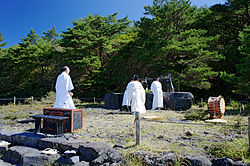

Buddhism and Shintoism are the two major religions in Japan. According to the annual statistical research on religion in 2015 by the Agency for Culture Affairs, Government of Japan, 70.4 percent of the population practices Shintoism, 69.8 percent Buddhism, 1.5 percent Christianity, and 6.9 percent others. Total adherents exceeds 100% because many (91.6%) Japanese people practice both Shintoism and Buddhism. Most of the Japanese (50% to 80% considering degrees of syncretism with Buddhism, shinbutsu-shūgō) pray and worship ancestors and gods (神, kami, shin or, archaically, jin) at Shinto shrines or at private altars, while not identifying as "Shinto" or "Shintoist" in surveys. This is because these terms have little meaning for the majority of the Japanese, or because they define membership in Shinto organizations or sects. The term "religion" (宗教, shūkyō) itself in Japanese culture defines only organized religions (that is, religions with specific doctrines and required membership). People who identify as "non-religious" (無宗教, mushūkyō) in surveys actually mean that they do not belong to any religious organization, even though they may take part in Shinto rituals and worship. Jesse LeFebvre has explored the manner in which "non-religiousness" is deployed as an identity by Japanese in articulating their religious outlook.
Some scholars, such as Jun'ichi Isomae and Jason Ānanda Josephson, have challenged the usefulness of the term "religion" in regard to Japanese "traditions", arguing that the Japanese term and concept of "religion" (shūkyō) is an invention of the 19th century. However, other scholars, such as Hans Martin Kramer and Ian Reader, regard such claims as overstated and contend that the terms relate to terminology and categorizations that existed in Japan prior to the 19th century.
Main religions
Shinto
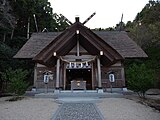 Takabe-jinja in Minamibōsō, Chiba. It's an example of the native shinmei-zukuri style.
Takabe-jinja in Minamibōsō, Chiba. It's an example of the native shinmei-zukuri style.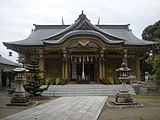 Haiden of the Izanagi-jinja in Suita, Osaka.
Haiden of the Izanagi-jinja in Suita, Osaka. Tenman-gū in Nagaokakyō, Kyoto.
Tenman-gū in Nagaokakyō, Kyoto.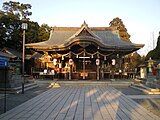 Shrine of Hachiman in Ube, Yamaguchi.
Shrine of Hachiman in Ube, Yamaguchi. Shrine of god Ontake on the Otaki peak of Mount Ontake.
Main article: Shinto
See also: Association of Shinto Shrines
Shrine of god Ontake on the Otaki peak of Mount Ontake.
Main article: Shinto
See also: Association of Shinto Shrines
Shinto (神道, Shintō), also kami-no-michi, is the indigenous religion of Japan and of most of the people of Japan. George Williams classifies Shinto as an action-centered religion; it focuses on ritual practices to be carried out diligently in order to establish a connection between present-day Japan and its ancient roots. The written historical records of the Kojiki and Nihon Shoki first recorded and codified Shinto practices in the 8th century. Still, these earliest Japanese writings do not refer to a unified "Shinto religion", but rather to a collection of native beliefs and of mythology. Shinto in the 21st century is the religion of public shrines devoted to the worship of a multitude of gods (kami), suited to various purposes such as war memorials and harvest festivals, and applies as well to various sectarian organizations. Practitioners express their diverse beliefs through a standard language and practice, adopting a similar style in dress and ritual dating from around the time of the Nara (710-794) and Heian (794-1185) periods.
The Japanese adopted the word Shinto ("way of the gods"), originally as Shindo, from the written Chinese Shendao (神道, pinyin: shén dào), combining two kanji: "shin" (神), meaning "spirit" or kami; and "tō" (道), meaning a philosophical path or study (from the Chinese word dào). The oldest recorded usage of the word Shindo dates from the second half of the 6th century. Kami are defined in English as "spirits", "essences" or "gods", referring to the energy generating the phenomena. Since the Japanese language does not distinguish between singular and plural, kami refers to the divinity, or sacred essence, that manifests in multiple forms: rocks, trees, rivers, animals, places, and even people can be said to possess the nature of kami. Kami and people are not separate; they exist within the same world and share its interrelated complexity.
Shinto is the largest religion in Japan, practiced by nearly 80% of the population, yet only a small percentage of these identify themselves as "Shintoists" in surveys. This is due to the fact that "Shinto" has different meanings in Japan: most of the Japanese attend Shinto shrines and beseech kami without belonging to Shinto organisations, and since there are no formal rituals to become a member of folk "Shinto", "Shinto membership" is often estimated counting those who join organised Shinto sects. Shinto has 100,000 shrines and 78,890 priests in the country.
Shinto sects and new religions
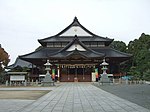 Main shrine of Shinriism (神理教 Shinrikyō) in Kitakyushu, Fukuoka Prefecture.
Main shrine of Shinriism (神理教 Shinrikyō) in Kitakyushu, Fukuoka Prefecture. Headquarters of Sukyo Mahikari in Takayama, Gifu Prefecture.
Headquarters of Sukyo Mahikari in Takayama, Gifu Prefecture.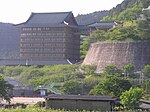 Headquarters of Ennoism (円応教 En'nōkyō) in Hyōgo Prefecture.
Headquarters of Ennoism (円応教 En'nōkyō) in Hyōgo Prefecture. A church of Sekai Shindoism (世界心道教 Sekai Shindōkyō) in Sendai, Miyagi Prefecture.
Main article: Shinto sects and schools
Further information: Japanese new religions
A church of Sekai Shindoism (世界心道教 Sekai Shindōkyō) in Sendai, Miyagi Prefecture.
Main article: Shinto sects and schools
Further information: Japanese new religions
Profound changes occurred in Japanese society in the 20th century (especially after World War II), including rapid industrialisation and urbanisation. Traditional religions, challenged by the transformation, underwent a reshaping themselves, and principles of religious freedom articulated by the 1947 constitution provided space for the proliferation of new religious movements.
New sects of Shinto, as well as movements claiming a thoroughly independent status, and also new forms of Buddhist lay societies, provided ways of aggregation for people uprooted from traditional families and village institutions. While traditional Shinto has a residential and hereditary basis, and a person participates in the worship activities devoted to the local tutelary deity or ancestor - occasionally asking for specific healing or blessing services or participating in pilgrimages - in the new religions individuals formed groups without regard to kinship or territorial origins, and such groups required a voluntary decision to join. These new religions also provided cohesion through a unified doctrine and practice shared by the nationwide community.
The officially recognized new religions number in the hundreds, and total membership reportedly numbers in the tens of millions. The largest new religion, Soka Gakkai, a Buddhist sect founded in 1930, has about 10 million members in Japan. Scholars in Japan have estimated that between 10% and 20% of the population belongs to the new religions, although more realistic estimates put the number at well below the 10% mark. As of 2007 there are 223,831 priests and leaders of the new religions in Japan, three times the number of traditional Shinto priests.
Many of these new religions derive from Shinto, retain the fundamental characters of Shinto, and often identify themselves as forms of Shinto. These include Tenrikyo, Konkokyo, Omotokyo, Shinrikyo, Shinreikyo, Sekai Shindokyo, Zenrinkyo and others. Others are independent new religions, including Aum Shinrikyo, Mahikari movements, the Church of Perfect Liberty, Seicho-no-Ie, the Church of World Messianity, and others.
Buddhism
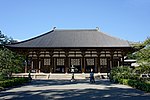 Tōshōdai-ji, an early Buddhist temple in Nara.
Tōshōdai-ji, an early Buddhist temple in Nara. Myoudou-ji, a Jodo Shin temple with distinctive architectural style.
Myoudou-ji, a Jodo Shin temple with distinctive architectural style. Monju-in, a Shingon temple in Matsuyama, Ehime.
Monju-in, a Shingon temple in Matsuyama, Ehime. Inner hall of Hyakumanben chion-ji a Jodo temple in Kyoto.
Inner hall of Hyakumanben chion-ji a Jodo temple in Kyoto.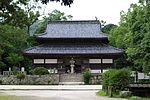 Kanzeon-ji, a Tendai temple in Dazaifu, Fukuoka.
Kanzeon-ji, a Tendai temple in Dazaifu, Fukuoka. Center of the Risshō Kōsei Kai in Kobe.
Center of the Risshō Kōsei Kai in Kobe.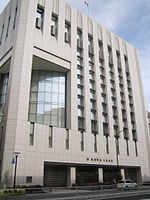 Headquarters of the Soka Gakkai in Shinjuku, Tokyo.
Main article: Buddhism in Japan
Headquarters of the Soka Gakkai in Shinjuku, Tokyo.
Main article: Buddhism in Japan
Buddhism (仏教 Bukkyō) first arrived in Japan in the 6th century, it was introduced in the year 538 or 552 from the kingdom of Baekje in Korea. The Baekje king sent the Japanese emperor a picture of the Buddha and some sutras. After overcoming brief yet violent oppositions by conservative forces, it was accepted by the Japanese court in 587. The Yamato state ruled over clans (uji) centered around the worship of ancestral nature deities. It was also a period of intense immigration from Korea, horse riders from northeast Asia, as well as cultural influence from China, that had been unified under the Sui dynasty becoming the crucial power on the mainland. Buddhism was functional to affirm the state's power and mold its position in the broader culture of East Asia. Japanese aristocrats set about building Buddhist temples in the capital at Nara, and then in the later capital at Heian (now Kyoto).
The six Buddhist sects initially established in Nara are today together known as "Nara Buddhism" and are relatively small. When the capital moved to Heian, more forms of Buddhism arrived from China, including the still-popular Shingon Buddhism, an esoteric form of Buddhism similar to Tibet's Vajrayana Buddhism, and Tendai, a monastic conservative form known better by its Chinese name, Tiantai.
When the shogunate took power in the 12th century and the administrative capital moved to Kamakura, more forms of Buddhism arrived. The most popular was Zen, which became the most popular type of Buddhism of that time. Two schools of Zen were established, Rinzai and Sōtō; a third, Ōbaku, formed in 1661.
With the Meiji Restoration in 1868, that involved the centralisation of imperial power and the modernisation of the state, Shinto was made the state religion and an order of elimination of mutual influence of Shinto and Buddhism was enacted, followed by a movement to thoroughly eradicate Buddhism.
Nowadays, the most popular branch is Pure Land Buddhism, arrived in the Kamakura period. It emphasizes the role of Amitabha Buddha and promises that reciting the phrase "Namu Amida Butsu" upon death will result in being removed by Amitabha to the "Western Paradise" or "Pure Land", and then to Nirvana. Pure Land attracted the merchant and farmer classes. After Honen, Pure Land's head missionary in Japan, died, the form split into two schools: Jōdo-shū, which focuses on repeating the phrase many times, and the more liberal Jōdo Shinshū, which claims that only saying the phrase once with a pure heart is necessary. Today, many Japanese adhere to Nishi Honganji-ha, a conservative sect of Jodo Shinshu.
Another prevalent form of Buddhism is Nichiren Buddhism, which was established by the 13th century monk Nichiren who underlined the importance of the Lotus Sutra. Main representatives of Nichiren Buddhism are sects like Nichiren Shū, Nichiren Shōshū and lay organisations like Risshō Kōsei Kai and Soka Gakkai, a controversial denomination whose political wing forms the Komeito, Japan's third largest political party. Common to most lineages of Nichiren Buddhism is the chanting of Nam(u) Myōhō Renge Kyō (or Nam Myoho Renge Kyo) and the Gohonzon inscribed by Nichiren.
As of 2018, there were 355,000+ Buddhist monks, priests and leaders in Japan, an increase of over 40,000 compared to 2000.
Minor religions
Christianity
 Matsugame Catholic Church in Utsunomiya, Tochigi Prefecture.
Matsugame Catholic Church in Utsunomiya, Tochigi Prefecture. Motomachi Catholic Church in Hakodate, Hokkaido.
Motomachi Catholic Church in Hakodate, Hokkaido. Saint Mary's Catholic Cathedral of Tokyo.
Saint Mary's Catholic Cathedral of Tokyo. Holy Resurrection Cathedral in Tokyo, of the Japanese Orthodox Church.
Holy Resurrection Cathedral in Tokyo, of the Japanese Orthodox Church. A Baptist church in Futaba, Fukushima Prefecture (before the disaster in 2011).
A Baptist church in Futaba, Fukushima Prefecture (before the disaster in 2011).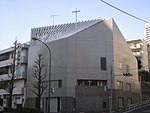 Grace Church, a Reformed church in Tokyo.
Main article: Christianity in Japan
See also: Protestantism in Japan, Catholicism in Japan, Kakure Kirishitan, and Japanese Orthodox Church
Grace Church, a Reformed church in Tokyo.
Main article: Christianity in Japan
See also: Protestantism in Japan, Catholicism in Japan, Kakure Kirishitan, and Japanese Orthodox Church
Christianity (キリスト教 Kirisutokyō), in the form of Catholicism (カトリック教 Katorikkukyō), was introduced into Japan by Jesuit missions starting in 1549. In that year, the three Jesuits Francis Xavier, Cosme de Torres and Juan Fernández, landed in Kagoshima, in Kyushu, on 15 August. Portuguese traders were active in Kagoshima since 1543, welcomed by local daimyōs because they imported gunpowder. Anjirō, a Japanese convert, helped the Jesuits understanding Japanese culture and translating the first Japanese catechism.
These missionaries were successful in converting large numbers of people in Kyushu, including peasants, former Buddhist monks, and members of the warrior class. In 1559, a mission to the capital, Kyoto, was started. By the following year there were nine churches, and the Christian community grew steadily in the 1560s. By 1569 there were 30,000 Christians and 40 churches. Following the conversion of some lords in Kyushu, mass baptisms of the local populations occurred, and in the 1570s the number of Christians rose rapidly to 100,000. In the domains of Christian local lords, non-Christians were forced to accept baptism and shrines; Buddhist temples were converted into churches or destroyed.
Near the end of the 16th century, Franciscan missionaries arrived in Kyoto, despite a ban issued by Toyotomi Hideyoshi. In 1597, Hideyoshi proclaimed a more serious edict and executed 26 Franciscans in Nagasaki as a warning. Tokugawa Ieyasu and his successors enforced the prohibition of Christianity with several further edicts, especially after the Shimabara Rebellion in the 1630s. Many Christians continued to practice in secret.
In 1873, following the Meiji Restoration, the ban was rescinded, freedom of religion was promulgated, and Protestant missionaries (プロテスタント Purotesutanto or 新教 Shinkyō, "renewed teaching") began to proselytise in Japan, intensifying their activities after World War II, yet they were never as successful as in Korea.
Today, there are 1 to 3 million Christians in Japan, most of them living in the western part of the country, where the missionaries' activities were greatest during the 16th century. Nagasaki Prefecture has the highest percentage of Christians: about 5.1% in 1996. As of 2007 there are 32,036 Christian priests and pastors in Japan. Throughout the latest century, some Western customs originally related to Christianity (including Western style weddings, Valentine's Day and Christmas) have become popular among many of the Japanese. For example, 60-70% of weddings performed in Japan are Christian-style.
Islam
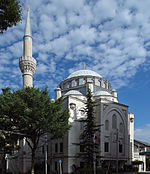
Islam (イスラム教 Isuramukyō) in Japan is mostly represented by small immigrant communities from other parts of Asia. In 2008, Keiko Sakurai estimated that 80–90% of the Muslims in Japan were foreign-born migrants primarily from Indonesia, Pakistan, Bangladesh, and Iran. It has been estimated that the Muslim immigrant population amounts to 70,000–100,000 people, while the "estimated number of Japanese Muslims ranges from thousands to tens of thousands".
Bahá'í Faith
Main article: Bahá'í Faith in JapanThe Bahá'í Faith (バハーイー教 Bahāīkyō) in Japan began after a few mentions of the country by `Abdu'l-Bahá first in 1875. The first Japanese convert was Kanichi Yamamoto (山本寛一), who lived in Honolulu, and accepted the faith in 1902; the second convert was Saichiro Fujita (藤田左弌郎). The first Bahá'í convert on Japanese soil was Kikutaro Fukuta (福田菊太郎) in 1915. Almost a century later, the Association of Religion Data Archives (relying on World Christian Encyclopedia) estimated some 15,700 Bahá'ís in 2005.
Judaism
Main articles: History of the Jews in Japan and Jewish settlement in Imperial JapanJudaism (ユダヤ教 Yudayakyō) in Japan is practiced by about 2,000 Jews living in the country. With the opening of Japan to the external world in 1853 and the end of Japan's sakoku foreign policy, some Jews immigrated to Japan from abroad, with the first recorded Jewish settlers arriving at Yokohama in 1861. The Jewish population continued to grow into the 1950s, fueled by immigration from Europe and the Middle East, with Tokyo and Kobe forming the largest communities.
During World War II, some European Jews fleeing the Holocaust found refuge in Japan, with one Japanese diplomat, Chiune Sugihara, the Japanese consul to Lithuania, disregarding his orders and issuing more than 6,000 entry visas to Jews fleeing the Nazis. After World War II, a large portion of Japan's Jewish population emigrated, many going to what would become Israel. Some of those who remained married locals and were assimilated into Japanese society.
There are community centres serving Jews in Tokyo and Kobe. The Chabad-Lubavitch organization has two centers in Tokyo.
In September 2015, Japan nominated a Chief Rabbi for the first time, the head of Tokyo's Chabad House, Rabbi Binyamin Edre'i.
Hinduism
Main article: Hinduism in Japan
Hinduism (ヒンドゥー教 Hindūkyō or 印度教 Indokyō) in Japan is practiced by a small number of people, mostly migrants from India, Nepal, Bali. Nevertheless, Hindu themes have had a significant but indirect role in Japanese culture, through the spread of Buddhism. Four of the Japanese "Seven Gods of Fortune" originated as Hindu deities, including Benzaiten (Sarasvati), Bishamon (Vaiśravaṇa or Kubera), Daikoku (Mahakala/Shiva), and Kisshoutennyo (Laxmi). Various Hindu deities, including the aforementioned, are worshipped in Shingon Buddhism. This denomination, and all other forms of Tantric Buddhism, borrow heavily from Tantric Hinduism.
Sikhism
Main article: Sikhism in JapanSikhism (シク教 Sikukyō) is presently a minority religion in Japan mainly followed by families migrated from India.
Jainism
Main article: Jainism in JapanJainism (ジャイナ教 Jainakyō) is a minority religion in Japan. As of 2009, there were three Jain temples in the country.
Other religions of East Asia
Ryukyuan religion

The Ryukyuan religion is the indigenous belief system of the people of Okinawa and the other Ryukyu Islands. While specific legends and traditions may vary slightly from place to place and island to island, the Ryukyuan religion is generally characterized by ancestor worship (more accurately termed "ancestor respect") and the respecting of relationships between the living, the dead, and the gods and spirits of the natural world. Some of its beliefs, such as those concerning genius loci spirits and many other beings classified between gods and humans, are indicative of its ancient animistic roots, as is its concern with mabui (まぶい), or life essence.
One of its most ancient features is the belief onarigami (おなり神), the spiritual superiority of women derived from the goddess Amamikyu, which allowed for the development of a class of noro (priestesses) cult and yuta (female media). This differs from Japanese Shinto, where men are seen as the embodiment of purity. Ryukyuan religion has been influenced by Japanese Shinto and Buddhism, and various Chinese religions. It includes sects and reformed movements such as Ijun or Ijunism (Ryukyuan: いじゅん Ijun; Japanese: 違順教 Ijunkyō), founded in the 1970s.
Ainu folk religion
Main article: Ainu religionThe Ainu religion アイヌの宗教 (Ainu no shūkyō) is the indigenous belief system of the Ainu people of Hokkaido and parts of Far Eastern Russia. It is an animistic religion centered around the belief that Kamuy (spirits or gods) live in everything.
Chinese folk religion
Main article: Chinese folk religion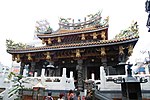
Most Chinese people in Japan practice the Chinese folk religion (Chinese: 中国民间宗教 or 中国民间信仰; pinyin: Zhōngguó mínjiān zōngjiào or Zhōngguó mínjiān xìnyǎng; Japanese: 中国の民俗宗教; rōmaji: Chūgoku no minzoku shūkyō), also known as Shenism (Chinese: 神教; pinyin: Shénjiào; Japanese pronunciation: Shinkyō), that is very similar to Japanese Shinto.
The Chinese folk religion consists in the worship of the ethnic Chinese gods and ancestors, shen (神 "gods", "spirits", "awarenesses", "consciousnesses", "archetypes"; literally "expressions", the energies that generate things and make them thrive), which can be nature deities, city deities or tutelary deities of other human agglomerations, national deities, cultural heroes and demigods, ancestors and progenitors of kinships. Holy narratives regarding some of these gods are codified into the body of Chinese mythology.
Taoism
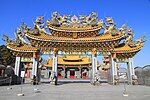
Taoism (道教 Dōkyō) was introduced from China between the 7th and 8th centuries, and influenced in varying degrees the Japanese indigenous spirituality. Taoist practices were absorbed into Shinto, and Taoism was the source of the esoteric and mystical religions of Onmyōdō, Shugendō and Kōshin.
Taoism, being an indigenous religion in China, shares some roots with Shinto, although Taoism is more hermetic while Shinto is more shamanic. Taoism's influence in Japan has been less profound than that of Japanese Neo-Confucianism. Today, institutional Chinese Taoism is present in the country in the form of some temples; the Seitenkyū was founded in 1995.
Confucianism
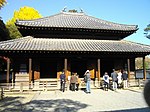
Confucianism (儒教 Jukyō) was introduced from Korea during the Japanese invasions of Korea (1592–1598), and developed into an elite religion, yet having a profound influence on the fabric of Japanese society overall during the Edo period. The Confucian philosophy can be characterized as humanistic and rationalistic, with the belief that the universe could be understood through human reason, corresponding to the universal reason (li), and thus it is up to man to create a harmonious relationship between the universe (天 Ten) and the individual. The rationalism of Neo-Confucianism was in contrast to the mysticism of Zen Buddhism in Japan. Unlike the Buddhists, the Neo-Confucians believed that reality existed, and could be understood by mankind, even if the interpretations of reality were slightly different depending on the school of Neo-Confucianism.
The social aspects of the philosophy are hierarchical with a focus on filial piety. This created a Confucian social stratification in Edo society that previously had not existed, dividing Japanese society into four main classes: samurai, farmers, artisans and merchants. The samurai were especially avid readers and teachers of Confucian thought in Japan, establishing many Confucian academies.
Neo-Confucianism also introduced elements of ethnocentrism into Japan. As the Chinese and Korean Neo-Confucians had regarded their own culture as the center of the world, the Japanese Neo-Confucians developed a similar national pride. This national pride would later evolve into the philosophical school of Kokugaku, which would later challenge Neo-Conufucianism, and its perceived foreign Chinese and Korean origins, as the dominant philosophy of Japan.
Religious practices and holidays
Most Japanese participate in rituals and customs derived from several religious traditions. Life cycle events are often marked by visits to a Shinto shrine. The birth of a new baby is celebrated with a formal shrine visit at the age of about one month, as are the third, fifth, and seventh birthdays (Shichi-Go-San) and the official beginning of adulthood at age twenty (Seijin shiki). Wedding ceremonies are often performed by Shinto priests, but Western-style secular wedding ceremonies, called howaito uedingu ("white wedding"), are also popular. These use Christian-like liturgy but are usually not presided over by an ordained priest.
Japanese funerals are usually performed by Buddhist priests, and Buddhist rites are also common on death day anniversaries of deceased family members. 91% of Japanese funerals take place according to Buddhist traditions.
There are two categories of holidays in Japan: matsuri (temple fairs), which are largely of Shinto origin and relate to the cultivation of rice and the spiritual well-being of the local community; and nenjyū gyōji (annual feasts), which are largely of Chinese or Buddhist origin. During the Heian period, the matsuri were organized into a formal calendar, and other festivals were added. Very few matsuri or annual feasts are national holidays, but they are included in the national calendar of annual events. Most matsuri are local events and follow local traditions. They may be sponsored by schools, towns, or other groups but are most often associated with Shinto shrines.
Some of the holidays are secular in nature, but the two most significant for the majority of Japanese—New Year's Day and Obon—involve visits to Shinto shrines or Buddhist temples, respectively. The New Year's holiday (January 1–3) is marked by the practice of numerous customs and the consumption of special foods. Visiting Shinto shrines or Buddhist temples to pray for family blessings in the coming year, dressing in a kimono, hanging special decorations, eating noodles on New Year's Eve, and playing a poetry card game are among these practices. During Obon, bon (spirit altars) are set up in front of Buddhist family altars, which, along with ancestral graves, are cleaned in anticipation of the return of the spirits. People living away from their family homes return for visits with relatives. Celebrations include folk dancing and prayers at Buddhist temples as well as family rituals in the home.
Religion and law
See also: Freedom of religion in JapanIn early Japanese history, the ruling class was responsible for performing propitiatory rituals, which later came to be identified as Shinto, and for the introduction and support of Buddhism. Later, religious organization was used by regimes for political purposes; for instance, the Tokugawa government required each family to be registered as a member of a Buddhist temple. In the early 19th century, the government required that each family belong to a shrine instead, and in the early 20th century, this was supplemented with the concept of a divine right to rule bestowed on the emperor. The Meiji Constitution reads: "Japanese subjects shall, within limits not prejudicial to peace and order, and not antagonistic to their duties as subjects, enjoy freedom of religious belief".
Article 20 of the 1947 Constitution states: "Freedom of religion is guaranteed to all. No religious organization shall receive any privileges from the State, nor exercise any political authority". The United States privatized shrines and created the term "State Shinto" during the occupation of Japan to reform native Japanese ideas of church and state, under the belief that it had supported the rise of Japanese militarism before and during World War II.
In postwar years, the issue of the separation of Shinto and state arose in the Self-Defense Force Apotheosis Case. In 1973, Nakaya Takafumi, a member of the Japanese Self-Defense Forces and husband of Nakaya Yasuko, died in a traffic accident. Despite Yasuko’s refusal to provide relevant documents for her husband’s enshrinement at the Yamaguchi prefectural National-Protecting Shrine, the prefectural Veterans’ Association requested the information from the Self-Defense Forces and completed the enshrinement. As a result, in 1973, Yasuko sued the Yamaguchi Prefectural Branch of the Self-Defense Forces, on the grounds that the ceremony of apotheosis violated her religious rights as a Christian.
Although Yasuko won the case at two lower courts, the ruling was overturned by the Supreme Court of Japan on June 1, 1988, based on the precedent established by the Tsu City Shinto Groundbreaking Ceremony Case. First, the Supreme Court ruled that because the Veterans’ Association—which was not an organ of the state—had acted alone when arranging the ceremony of apotheosis, no violation of Article 20 had occurred. Second, the Supreme Court held that the Self-Defense Forces' provision of Takafumi’s documents to the Veterans’ Association did not constitute a religious activity prohibited by Article 20, because neither the intention nor the effects of its action harmed or patronized any religion.
Third, the Supreme Court adopted a narrow interpretation of individual religious rights, by ruling that violation of individual rights to religion did not occur unless the state or its organs coerced individuals to perform some religious activity or limited their religious freedom. On June 2, 1988, a report by the Los Angeles Times described the Japanese Supreme Court’s decision as “a major setback for advocates of stronger separation of religion and state in Japan.” On June 7, 1988, an article published in the New York Times expressed concern that the Japanese Supreme Court’s decision was likely to encourage the resurgence of State Shinto and nationalism. Because the prefectural National-Protecting Shrines perform the same ceremony of apotheosis as the Yasukuni Shrine does, the significance of this case also lies in its implications for the constitutionality of state patronage of and official visits to the Yasukuni Shrine.
Thoughts and movements against organised religion
Shichihei Yamamoto argues that Japan has shown greater tolerance towards irreligion, saying, "Japan had nothing like the trial of Galileo or the 'monkey trial' about evolution. No Japanese Giordano Bruno was ever burned at the stake for atheism".
Comments against religion by notable figures
- Shin'ichi Hisamatsu, philosopher and scholar who rejected theism, claimed that God or Buddha, as objective beings, are mere illusions.
- Prince Ito Hirobumi, four-time Prime Minister of Japan, who reportedly said: "I regard religion itself as quite unnecessary for a nation's life; science is far above superstition, and what is religion – Buddhism or Christianity – but superstition, and therefore a possible source of weakness to a nation? I do not regret the tendency to free thought and atheism, which is almost universal in Japan because I do not regard it as a source of danger to the community".
- Hiroyuki Kato, who headed the Imperial Academy from 1905–1909 and said: "Religion depends on fear".
- Haruki Murakami, a Japanese novelist who wrote: "God only exists in people’s minds. Especially in Japan, God's always has been a kind of flexible concept. Look at what happened to the war. Douglas MacArthur ordered the divine emperor to quit being a God, and he did, making a speech saying he was just an ordinary person".
- Ando Shoeki, who denounced Confucian scholars and Buddhist clergy as spiritual oppressors of his age, though he still venerated the gods of old Japan as a pantheist would, equating them with the nature.
- Fukuzawa Yukichi, who was regarded as one of the founders of modern Japan and found it impossible to combine modern learning with belief in gods, openly declaring: "It goes without saying that the maintenance of peace and security in society requires a religion. For this purpose any religion will do. I lack a religious nature, and have never believed in any religion. I am thus open to the charge that I am advising others to be religious while I am not so. Yet my conscience does not permit me to clothe myself with religion when I have it not at heart...Of religions there are several kinds – Buddhism, Christianity, and what not. From my standpoint there is no more difference between those than between green tea and black...See that the stock is well selected and the prices cheap".
Anti-religious organisations
The Japan Militant Atheists Alliance (Nihon Sentoteki Mushinronsha Domei, also known as Senmu) was founded in September 1931 by a group of antireligious people. The alliance opposed the idea of kokutai, the nation's founding myth, the presence of religion in public education, and the practice of State Shinto. Their greatest opposition was towards the imperial system of Japan.
Two months later, in November 1931, socialist Toshihiko Sakai and Communist Takatsu Seido created the Japan Anti-religion Alliance (Nihon Hanshukyo Domei). They opposed "contributions to religious organizations, prayers for practical benefits (kito), preaching in factories, and the religious organizations of all stripes" and viewed religion as a tool used by the upper class to suppress laborers and farmers.
Demographics
National statistics
According to the annual statistical research on religion in 2015 by the Agency for Culture Affairs, Government of Japan: there are 181 thousand religious groups in Japan.
| Religion | Percentage | Population (in million) |
|---|---|---|
| Shintoism | 70.4% | 89.5 |
| Buddhism | 69.8% | 88.7 |
| Christianity | 1.5% | 1.9 |
| Other | 6.9% | 8.9 |
| Total | 100% | 127.1 |
- Note: Total adherents exceeds 100% because 91.6% (116.4 million) Japanese people practice both Shintoism and Buddhism.
Other statistics
Some estimates indicate that 84% to 96% of Japanese people identify themselves as both Buddhist and Shinto.
According to surveys carried out in 2006 and 2008, less than 40% of the population of Japan identifies with an organized religion: around 35% are Buddhists, 3% to 4% are members of Shinto sects and derived religions, and from fewer than 1% to 2.3% are Christians.
Religious denominations in Japan (1996)
Pure Land Buddhism (12.9%) Zen Buddhism (4.1%) Tendai or Shingon Buddhism (4%) Soka Gakkai (3%) Nichiren Buddhism (3%) Other Buddhist schools (2.5%) Christianity (2%) Shinto sects (1%) Folk Shinto or no religion (67.5%)| Religion | 1984 | 1996 | 2008 |
|---|---|---|---|
| Japanese Buddhism | 27% | 29.5% | 34% |
| Shinto sects | 3% | 1% | 3% |
| Christianity | 2% | 2% | 1% |
| Prefecture | Tendai or Shingon | Pure Land | Zen | Nichiren | Soka Gakkai | Other Buddhist schools | Buddhism overall | Shinto sects | Christianity | Folk Shinto or none |
|---|---|---|---|---|---|---|---|---|---|---|
| Hokkaido | ~3% | 13.3% | 8.2% | 3.2% | ~2% | ~2% | ~31.7% | ~2% | ~1% | ~65.3% |
| Aomori Prefecture | ~1% | 10.3% | 5.6% | 3.4% | ~2% | ~3% | ~25.3% | ~2% | ~1% | ~71.7% |
| Iwate Prefecture | ~2% | 6.1% | 12.8% | ~0 | ~2% | ~3% | ~25.9% | ~0 | ~1% | ~73.1% |
| Miyagi Prefecture | ~3% | 4.8% | 9.5% | ~2% | ~2% | ~2% | ~23.3% | ~0 | ~1% | ~75.7% |
| Akita Prefecture | ~0 | 6.9% | 9.5% | ~3% | ~2% | ~2% | ~21.4% | ~3% | ~0 | ~75.6% |
| Yamagata Prefecture | ~4% | 5.6% | 8.5% | ~3% | ~3% | 3.4% | ~27.5% | ~2% | ~1% | ~69.5% |
| Fukushima Prefecture | 5.2% | 4.8% | 5.2% | ~0 | ~3% | ~3% | ~21.2% | ~0 | ~0 | ~78.8% |
| Ibaraki Prefecture | 7.1% | 4.1% | ~2% | ~2% | ~3% | ~2% | ~20.2% | ~1% | ~1% | ~77.8% |
| Tochigi Prefecture | 6% | 3.1% | ~3% | ~3% | 3.1% | ~2% | ~20.2% | ~0 | ~1 | ~78.8% |
| Gunma Prefecture | 6.6% | 3.6% | 5.8% | ~3% | ~3% | ~2% | ~24% | ~1% | ~2% | ~73% |
| Saitama Prefecture | 5.8% | 5.2% | ~3% | ~2% | 3.3% | ~1% | ~20.3% | ~0 | ~2% | ~77.7% |
| Chiba Prefecture | 3.8% | 4.5% | ~1% | 3.3% | ~3% | ~1% | ~16.6% | ~0 | ~1% | ~82.4% |
| Tokyo | 3.4% | 8.3% | ~2% | 3.3% | 4% | ~2% | ~23% | ~1% | 3.4% | ~72.6% |
| Kanagawa Prefecture | ~3% | 5.5% | 3.7% | 3.7% | 3.5% | ~2% | ~21.4% | ~1% | ~3% | ~74.6% |
| Niigata Prefecture | 3.2% | 10.6% | 4.9% | ~1% | ~2% | ~2% | ~23.7% | ~1% | ~1% | ~74.3% |
| Toyama Prefecture | ~2% | 41.3% | ~1% | ~2% | ~1% | ~1% | ~48.3% | ~0 | ~0 | ~51.7% |
| Ishikawa Prefecture | ~2 | 36.2% | ~1% | ~1% | ~0 | ~3% | ~43.2% | ~1% | ~1% | ~54.8% |
| Fukui Prefecture | ~2% | 41.4% | 5.5% | 3.9% | ~1% | ~3% | ~56.8% | ~1% | ~0 | ~42.2% |
| Yamanashi Prefecture | ~1% | 4.5% | 6.2% | 8.9% | ~3% | ~3% | ~26.6% | ~1% | ~1% | ~71.4% |
| Nagano Prefecture | 3.5% | 11.8% | 7.6% | ~2% | ~3% | ~2% | ~29.9% | ~1% | ~1% | ~68.1% |
| Gifu Prefecture | ~3% | 23.2% | 6.8% | ~1% | ~3% | ~1% | ~38.1% | ~1% | ~1% | ~59.9% |
| Shizuoka Prefecture | ~1% | 6.2% | 9.4% | 7.3% | 3.6% | ~4% | ~31.5% | ~1% | ~1% | ~66.5% |
| Aichi Prefecture | ~3% | 16.7% | 8.5% | ~1% | ~3% | ~2% | ~34.2% | ~2% | ~2% | ~61.8% |
| Mie Prefecture | ~3% | 22.9% | 4.2% | ~1% | ~2% | ~2% | ~35.1% | ~1% | ~1% | ~62.9% |
| Shiga Prefecture | 3% | 26.7% | 3.2% | ~2% | ~3% | ~0 | ~37.9% | ~0 | ~1% | ~61.1% |
| Kyoto Prefecture | ~3% | 17.5% | 3.4% | ~2% | ~3% | ~3% | ~31.9% | ~2% | ~2% | ~66.1% |
| Osaka Prefecture | 5.9% | 15.6% | ~3% | 3% | 5.2% | ~1% | ~33.7% | ~1% | ~1% | ~64.3% |
| Hyōgo Prefecture | 8.6% | 12.2% | 3.1% | ~3% | 3.1% | ~3% | ~33% | ~2% | ~2% | ~63% |
| Nara Prefecture | 4.2% | 17.3% | ~1% | ~3% | ~3% | ~2% | ~30.5% | ~0 | ~1% | ~68.5% |
| Wakayama Prefecture | 9.6% | 13.5% | ~3% | ~1% | 3.5% | ~2% | ~32.6% | ~0 | ~0 | ~67.4% |
| Tottori Prefecture | ~3% | 10.4% | 8.8% | 4% | ~2% | ~3% | ~31.2% | ~3% | ~1% | ~64.8% |
| Shimane Prefecture | ~4% | 18.4% | 6.5% | ~2% | ~1% | ~3% | ~30.9% | ~2% | ~1% | ~66.1% |
| Okayama Prefecture | 16.6% | 5.1% | 3% | 5.9% | ~3% | 0 | ~33.6% | ~2% | ~1% | ~63.4% |
| Hiroshima Prefecture | 4.4% | 35.3% | 3.6% | ~2% | 4.9% | ~1% | ~51.2% | ~2% | ~2% | ~44.8% |
| Yamaguchi Prefecture | ~3% | 21.9% | 3.8% | ~2% | 3.8% | ~1% | ~35.5% | ~1% | ~1% | ~62.5% |
| Tokushima Prefecture | 19.8% | 6.7% | ~0 | ~1% | 3% | ~1% | ~31.5% | ~1% | ~1% | ~66.5% |
| Kagawa Prefecture | 14% | 18% | ~1% | ~2% | ~3% | ~1% | ~39% | ~0 | ~1% | ~60% |
| Ehime Prefecture | 9.3% | 6.7% | 5.3% | ~2% | ~3% | ~1% | ~27.3% | ~1% | ~2% | ~69.7% |
| Kōchi Prefecture | 6.3% | 6.3% | ~0 | ~1% | ~3% | ~1% | ~17.6% | 5.5% | ~0 | ~76.9% |
| Fukuoka Prefecture | ~2% | 24.1% | 3.3% | 3% | 3.3% | ~2% | ~37.7% | ~1% | ~2% | ~59.3% |
| Saga Prefecture | ~4% | 21.9% | 6.1% | ~3% | ~2% | ~3% | ~40% | ~0 | ~0 | ~60% |
| Nagasaki Prefecture | 4.9% | 19.5% | 3.6% | 5.1% | ~3% | ~3% | ~39.1% | ~2% | 5.1% | ~53.8% |
| Kumamoto Prefecture | ~2% | 28.4% | ~3% | ~2% | ~2% | ~1% | ~38.4% | ~0 | ~1% | ~61.6% |
| Ōita Prefecture | ~3% | 20.7% | 4.7% | ~3% | ~3% | ~1% | ~35.4% | ~2% | ~1% | ~61.6% |
| Miyazaki Prefecture | ~3% | 18.2% | ~3% | ~3% | ~3% | 3.3% | ~33.5% | 3.8% | ~1% | ~61.7% |
| Kagoshima Prefecture | ~2% | 29.8% | ~1% | ~2% | ~3% | 6% | ~43.8% | ~3% | ~0 | ~53.2% |
| Okinawa Prefecture | ~0 | ~0 | ~0 | ~0 | 3.6% | ~0 | ~3,6% | ~0 | ~3 | ~93.4% |
| Japan | 4% | 12.9% | 4.1% | ~3% | 3% | ~2.5% | ~29.5% | ~1% | ~2% | ~67.5% |
See also
Footnotes
- According to the annual statistical research on religion in 2015 by the Agency for Culture Affairs, Government of Japan, 70.4% Shinto and 69.8% Buddhist in Japan. Total adherents exceeds 100% because many Japanese people (91.6%) practice both Shintoism and Buddhism.
- Both mean the "way of the divine" or "of the gods". Other names are:
- kannagara-no-michi, "way of the divine transmitted from time immemorial";
- Kodo, the "ancient way";
- Daido, the "great way";
- Teido, the "imperial way".
- During the history of China, at the time of the spread of Buddhism to that country c. 1st century CE, the name Shendao identified what is currently known as "Shenism", the Chinese indigenous religion, distinguishing it from the new Buddhist religion. (Brian Bocking. A Popular Dictionary of Shinto. Routledge, 2005. ASIN: B00ID5TQZY p. 129)
- According to the Dentsu survey of 2006: 1% Protestants, 0.8% members of the Catholic Church and 0.5% members of the Orthodox Church.
- Mostly Ryūkyūshintō.
References
- https://www.pewresearch.org/wp-content/uploads/sites/7/2017/11/Religion20171117.pdf
- https://www.indexmundi.com/japan/religions.html
- https://www.learnreligions.com/religion-in-japan-4782051
- https://www.cia.gov/library/publications/the-world-factbook/fields/401.html
- https://www.cia.gov/library/publications/the-world-factbook/geos/ja.html
- https://www.pewresearch.org/wp-content/uploads/sites/7/2017/11/Religion20171117.pdf
- https://www.indexmundi.com/japan/religions.html
- https://www.learnreligions.com/religion-in-japan-4782051
- https://www.cia.gov/library/publications/the-world-factbook/fields/401.html
- https://www.cia.gov/library/publications/the-world-factbook/geos/ja.html
- Reischauer, Edwin O.; Jansen, Marius B. (1988). The Japanese today: change and continuity (2nd ed.). Belknap Press of Harvard University Press. p. 215. ISBN 978-0-674-47184-9.
- ^ Breen, Teeuwen. 2000. p. 3
- ^ Engler, Price. 2005. p. 95
- ^ Williams, 2004. pp. 4-5
- ^ Bestor, Yamagata. 2011. pp. 66-67
- LeFebvre, J. (2015). Christian wedding ceremonies: “Nonreligiousness” in contemporary Japan. Japanese Journal of Religious Studies, 42(2), 185-203. http://nirc.nanzan-u.ac.jp/nfile/4454
- Isomae Jun'ichi 磯前順一. 2003. 近代日本の宗教言說とその系譜. Tōkyō: Iwanami Shoten. Josephson, Jason Ānanda. 2012. The Invention of Religion in Japan. Chicago: The University of Chicago Press.
- Krämer, Hans Martin (2013). "How "Religion" Came to Be Translated as "Shūkyō": Shimaji Mokurai and the Appropriation of Religion in Early Meiji Japan". Japan Review (25): 89–111. JSTOR 41959187.
- Reader, Ian (2016). "Problematic Conceptions and Critical Developments – The Construction and Relevance of Religion and Religious Studies in Japan" (PDF). The Journal of the Irish Society for the Academic Study of Religions. 3: 198–218.
- Stuart D. B. Picken, 1994. p. xxiv
- Williams, 2004. p. 4
-
Williams, George (2004). Shinto. Religions of the World. Philadelphia: Infobase Publishing (published 2009). p. 6. ISBN 9781438106465. Retrieved 12 May 2019.
Shinto is an action-centered religion (one based on actions) and not a confessional religion (one that requires a set of beliefs or a profession of faith).
- John Nelson. A Year in the Life of a Shinto Shrine. 1996. pp. 7–8
- ^ Richard Pilgrim, Robert Ellwood (1985). Japanese Religion (1st ed.). Englewood Cliffs, New Jersey: Prentice Hall Inc. pp. 18–19. ISBN 978-0-13-509282-8.
- ^ Breen, Teeuwen. 2010. p. 1
- ^ Stuart D. B. Picken, 1994. p. xxi
- ^ Sokyo, Ono (1962). Shinto: The Kami Way (1st ed.). Rutland, VT: Charles E Tuttle Co. p. 2. ISBN 978-0-8048-1960-2. OCLC 40672426.
- ^ Stuart D. B. Picken, 1994. p. xxii
- Bestor, Yamagata, 2011, p. 65
- ^ Earhart, 2013. pp. 286-287
- Bestor, Yamagata. 2011. pp. 64-65.
- ^ Bestor, Yamagata. 2011. p. 65
- Earhart, 2013. pp. 289-290
- ^ Earhart, 2013. p. 290
- Shimazono, Susumu (2004). From Salvation to Spirituality: Popular Religious Movements in Modern Japan. Trans Pacific Press. pp. 234-235
- ^ Brown, 1993. p. 455
- ^ Brown, 1993. p. 456
- ^ Brown, 1993. p. 454
- Brown, 1993. p. 453
- Agency for Cultural Affairs (2019). 宗教年鑑 令和元年版 [Religious Yearbook 2019] (PDF) (in Japanese). p. 35.
- Agency for Cultural Affairs (2002). 宗教年鑑 平成13年版 [Religious Yearbook 2001] (PDF) (in Japanese). Agency for Cultural Affairs. p. 31. ISBN 978-432406748-2.
- ^ Higashibaba, 2002. p. 1
- Higashibaba, 2002. p. 5
- ^ Higashibaba, 2002. p. 12
- Higashibaba, 2002. p. 15
- Religion in Japan by prefecture. 1996 statistics.
- LeFebvre, J. (2015). Christian wedding ceremonies: “Nonreligiousness” in contemporary Japan. Japanese Journal of Religious Studies, 42(2), 185-203.
- Emile A. Nakhleh, Keiko Sakurai and Michael Penn; "Islam in Japan: A Cause for Concern?", Asia Policy 5, January 2008
- Yasunori Kawakami, "Local Mosques and the Lives of Muslims in Japan", Japan Focus, May 2007
- 'Abdu'l-Bahá (1990) . The Secret of Divine Civilization. Wilmette, Illinois: Bahá'í Publishing Trust. p. 111. ISBN 978-0-87743-008-7.
- Alexander, Agnes Baldwin (1977). Sims, Barbara (ed.). History of the Bahá'í Faith in Japan 1914-1938. Osaka, Japan: Japan Bahá'í Publishing Trust. pp. 12–4, 21.
- "Most Baha'i Nations (2005)". QuickLists. The Association of Religion Data Archives. 2005. Retrieved 2009-07-04.
- Golub, Jennifer (August 1992). "Japanese Attitudes Toward Jews" (PDF). Pacific Rim Institute of the American Jewish Committee.
{{cite journal}}: Cite journal requires|journal=(help) - "Jewish Community of Japan".
- "Jewish Community of Kansai".
- "Chabad Japan". Chabad Jewish Center of Japan.
- "Japan Gets First-Ever Chief Rabbi". September 17, 2015.
- 2009 Jain Diaspora Conference. Los Angeles, USA: JAINA: Federation of Jain Associations in North America. Retrieved 24 March 2012.
- Kim Ha-tai (April 1961), "The Transmission of Neo-Confucianism to Japan by Kang Hang, a Prisoner of War", Transactions of the Korea Branch of the Royal Asiatic Society (37): 83–103
- ^ Craig 1998, p. 552.
- Craig 1998, p. 553.
- LeFebvre, J. (2015). Christian wedding ceremonies: “Nonreligiousness” in contemporary Japan. Japanese Journal of Religious Studies, 42(2), 185-203. http://nirc.nanzan-u.ac.jp/nfile/4454
- ^ Hardacre, Helen (1989). Shintō and the State, 1868-1988. Princeton, NJ: Princeton University Press. p. 153. ISBN 978-0691020525.
- ^ Hardacre, Helen (1989). Shintō and the State, 1868-1988. Princeton, NJ: Princeton University Press. p. 154. ISBN 978-0691020525.
- Hardacre, Helen (1989). Shintō and the State, 1868-1988. Princeton, NJ: Princeton University Press. pp. 154–155. ISBN 978-0691020525.
- Hardacre, Helen (1989). Shintō and the State, 1868-1988. Princeton, NJ: Princeton University Press. p. 155. ISBN 978-0691020525.
- Schoenberger, Karl (1988-06-02). "Japan Widow Loses Religious Rights Case". Los Angeles Times. ISSN 0458-3035. Retrieved 2018-05-01.
- Haberman, Clyde. "Tokyo Journal; Shinto Is Thrust Back Onto the Nationalist Stage". Retrieved 2018-05-01.
- Shichihei, Yamamoto (1992). The spirit of Japanese capitalism and selected essays. Lanham: Madison Books. ISBN 9780819182944.
- Furuya, Yasuo (1997). A history of Japanese theology. Eerdmans Publishing. p. 94. ISBN 978-0802841087.
- ^ Gulic, Sidney L. (1997). Evolution of the Japanese, Social and Psychic. BiblioBazaar. p. 198. ISBN 9781426474316.
- Hays, Jeffrey (July 2012). "Religion in Japan and the Irreligious Japanese". Facts and Details. Retrieved 10 October 2015.
- Nakamura, Hajime (1992). A comparative history of ideas (1st Indian ed.). Delhi: Motilal Banarsidass. p. 519. ISBN 9788120810044.
- Thelle, Notto R. (1987). Buddhism and Christianity in Japan: from conflict to dialogue, 1854-1899. Honolulu: University of Hawaii Press. ISBN 978-0824810061.
- Robertson, J.M. (2010). A Short History of Freethought Ancient and Modern. Vol. 2. Forgotten Books. p. 425. ISBN 978-1440055249.
- ^ Ives, Christopher (2009). Imperial-Way Zen: Ichikawa Hakugen's critique and lingering questions for Buddhist ethics. Honolulu: University of Hawai'i Press. ISBN 9780824833312.
- https://www.pewresearch.org/wp-content/uploads/sites/7/2017/11/Religion20171117.pdf
- https://www.indexmundi.com/japan/religions.html
- https://www.learnreligions.com/religion-in-japan-4782051
- https://www.cia.gov/library/publications/the-world-factbook/fields/401.html
- https://www.cia.gov/library/publications/the-world-factbook/geos/ja.html
- https://books.google.co.in/books?id=4JMJP27VasMC&pg=PA159&lpg=PA159&dq=96%25+buddhist+population+in+japan&source=bl&ots=9_7tRpn9v4&sig=R6lv0GCO6hBS-bPsxQZubW4tptM&hl=en&sa=X&redir_esc=y#v=onepage&q=96%25%20buddhist%20population%20in%20japan&f=false
- Role of Japanese Culture in Psychological Health - SAGE Publications
- ^ Cite error: The named reference
Dentsu2006was invoked but never defined (see the help page). - ^ "2008 NHK survey of religion in Japan — 宗教的なもの にひかれる日本人〜ISSP国際比較調査(宗教)から〜" (PDF). NHK Culture Research Institute.
- Mariko Kato (February 24, 2009). "Christianity's long history in the margins". The Japan Times.
The Christian community itself counts only those who have been baptized and are currently regular churchgoers — some 1 million people, or less than 1 percent of the population, according to Nobuhisa Yamakita, moderator of the United Church of Christ in Japan
- "Christians use English to reach Japanese youth". Mission Network News. 3 September 2007. Archived from the original on 11 June 2010.
The population of Japan is less than one-percent Christian
- Heide Fehrenbach, Uta G. Poiger (2000). Transactions, transgressions, transformations: American culture in Western Europe and Japan. Berghahn Books. p. 62. ISBN 978-1-57181-108-0.
... followers of the Christian faith constitute only about a half percent of the Japanese population
- ^ Religion in Japan by prefecture, 1996. English language bar table.
- 1984 NHK survey of religion in Japan. Results recorded in: Bestor, Yamagata, 2011, p. 66
Sources
- LeFebvre, J. (2015). Christian Wedding Ceremonies: “Nonreligiousness” in Contemporary Japan. Japanese Journal of Religious Studies, 42(2), 185-203. http://nirc.nanzan-u.ac.jp/nfile/4454
- Earhart, H. Byron. Japanese Religion: Unity and Diversity, in The Religious Life of Man Series. Second ed. Encino, Calif.: Dickenson Publishing Co., 1974. ISBN 0-8221-0123-8
- Inoue, Nobutaka et al. Shinto, a Short History (London: Routledge Curzon, 2003) online
- Matsunaga, Daigan; Matsunaga, Alicia (1996), Foundation of Japanese Buddhism, Vol. 1: The Aristocratic Age, Los Angeles; Tokyo: Buddhist Books International. ISBN 0-914910-26-4
- Matsunaga, Daigan, Matsunaga, Alicia (1996), Foundation of Japanese Buddhism, Vol. 2: The Mass Movement (Kamakura and Muromachi Periods), Los Angeles; Tokyo: Buddhist Books International. ISBN 0-914910-28-0
- Picken, Stuart D. B. (1994). Essentials of Shinto an Analytical Guide to Principal Teachings. Westport, Conn.: Greenwood Press. ISBN 9780313369797.
- Reader, Ian (1991). Religion in Contemporary Japan, Honolulu: University of Hawaii Press
- Matsunami, Kodo (2004). "A guide to Japanese Buddhism". Tokyo: Japan Buddhist Federation.
{{cite web}}: Missing or empty|url=(help) PDF - Shimazono, Susumu (2004): From Salvation to Spirituality: Popular Religious Movements in Modern Japan. Trans Pacific Press
- Sims, Barbara (1989). Traces That Remain: A Pictorial History of the Early Days of the Bahá'í Faith Among the Japanese. Osaka, Japan: Japan Bahá'í Publishing Trust.
- Staemmler, Birgit, Dehn, Ulrich (ed.): Establishing the Revolutionary: An Introduction to New Religions in Japan. LIT, Münster, 2011. ISBN 978-3-643-90152-1
- Victoria Bestor, Theodore C. Bestor, Akiko Yamagata. Routledge Handbook of Japanese Culture and Society. Routledge, 2011. ASIN B004XYN3E4, ISBN 0415436494
- John Breen, Mark Teeuwen. Shinto in History. Curzon Press, Richmond, Surrey, England, 2000. ISBN 0700711708
- Steven Engler, Gregory P. Grieve. Historicizing "Tradition" in the Study of Religion. Walter de Gruyter, Inc., 2005. ISBN 3110188759. pp. 92–108
- George Williams, Ann Marie B. Bhar, Martin E. Marty. Shinto. Religions of the World. Chelsea House, 2004. ISBN 0791080978
- John Breen, Mark Teeuwen. A New History of Shinto. Blackwell, 2010. ISBN 1405155167
- Earhart H. Religion in Japan: Unity and Diversity. Cengage Learning, 2013. ISBN 1133934811
- Delmer Brown, John Whitney Hall. The Cambridge History of Japan, Volume 1. Cambridge University Press, 1993. ISBN 0521223520
- Ikuo Higashibaba. Christianity in Early Modern Japan: Kirishitan Belief and Practice. Brill Academic Publishing, 2002. ISBN 9004122907
- Craig, Edward (1998), Routledge Encyclopedia of Philosophy, Volume 7, Taylor & Francis, ISBN 978-0-415-07310-3
External links
- International Religious Freedom Report 2015: Japan, most recent International Religious Freedom Report by the United States Department of State's Bureau of Democracy, Human Rights, and Labor
- Fitzgerald, Tim (2003-07-10). "Religion and the Secular in Japan: Problems in History, Social Anthropology and the Study of Religion". Electronic Journal of Contemporary Japanese Studies.
- LeFebvre, J. (2015). Christian wedding ceremonies: “Nonreligiousness” in contemporary Japan. Japanese Journal of Religious Studies, 42(2), 185-203. http://nirc.nanzan-u.ac.jp/nfile/4454
| Japan articles | |||||||||||||
|---|---|---|---|---|---|---|---|---|---|---|---|---|---|
| History |
| ||||||||||||
| Geography | |||||||||||||
| Politics |
| ||||||||||||
| Economy | |||||||||||||
| Society | |||||||||||||